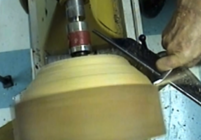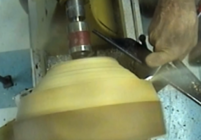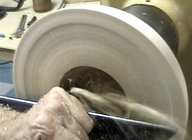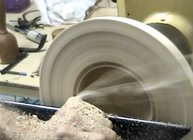Hi, I'm new to turning and when it's more convenient I've typically switched my hands (left hand on my hip rather than right hand) rather than put my body in an awkward position. I was taking a beginner class at our local club and the instructor was very surprised by this and made me feel like this wasn't a good idea. Most of the video's I've seen also don't show people switching hands, most people turn with their right hand on their hip and left hand near the tool rest. I'd be interested in what people here have to say on the subject, please let me know if I should stop switching - thanks!
-
We just finished moving the forums to a new hosting server. It looks like everything is functioning correctly but if you find a problem please report it in the Forum Technical Support Forum (click here) or email us at forum_moderator AT aawforum.org. Thanks! -
Beware of Counterfeit Woodturning Tools (click here for details) -
Johnathan Silwones is starting a new AAW chapter, Southern Alleghenies Woodturners, in Johnstown, PA. (click here for details) -
Congratulations to Dave Roberts for "2 Hats" being selected as Turning of the Week for April 22, 2024 (click here for details) -
Welcome new registering member. Your username must be your real First and Last name (for example: John Doe). "Screen names" and "handles" are not allowed and your registration will be deleted if you don't use your real name. Also, do not use all caps nor all lower case.
You are using an out of date browser. It may not display this or other websites correctly.
You should upgrade or use an alternative browser.
You should upgrade or use an alternative browser.
Right or Left Handed Turning?
- Thread starter Paul DuBose
- Start date
ambidextrous turning would be a huge advantage in my opinion. I’m a lefty and trying to learn right handed also.
Because I'm new, both ways feel about the same to me. Wondering if I should keep it up or focus on one side to improve faster.ambidextrous turning would be a huge advantage in my opinion. I’m a lefty and trying to learn right handed also.
Paul, as a new turner, if you can train yourself and continue to practice both left and right-handed tool control, you'll have a huge advantage over single-hand dominant turning, don't let anyone tell you otherwise. Learn for the long haul, not for instant results. Every time you do it, it becomes more natural, and it won't take long to set into your routine. There are times for both faceplate and between-centers turning that I'll go from a right-hand grip to a left-hand and back again and I'm not even thinking about it, I've done it this way since I started back in 1995. It is a matter of simple ergonomics of tool control- when the right-hand grip feels clumsy, go to left, back and forth. Don't limit yourself to just one grip.
I'm a righty, and when I started turning I was living in a small town, thought for sure nobody within a hundred miles was doing this, and guided myself with an old library book as I hacked away on some 2x2 construction lumber. Right hand, left hand. Left hand, right hand. The skill imprinted itself in my mind and muscles and I've done it this way ever since. Keep going!
I'm a righty, and when I started turning I was living in a small town, thought for sure nobody within a hundred miles was doing this, and guided myself with an old library book as I hacked away on some 2x2 construction lumber. Right hand, left hand. Left hand, right hand. The skill imprinted itself in my mind and muscles and I've done it this way ever since. Keep going!
I’m having a hard time imagining NOT changing hands in many situations. Using a skew from the headstock towards the tailstock I’m always left handed. From the tailstock, right handed.
Paul, keep practicing with both hands, im self taught and i have always turned with whichever hand put me in the most comfortable position and out of the line of fire as much as possible, i think its a great advantage
We must change hands, and it is easy, even as a beginner to do it. You are living proof of that. Forcing one hand is counterproductive and could be even dangerous, if you are using bevel supported cuts. With scrapers it is not as necessary.
This makes me think, if lathe mfr's. can build sliding and rotating headstocks, and outboard turning headstocks, it should be a natural extenstion to design a headstock that can be moved to the right end of the machine, and flip the tailstock accordingly, to the benefit of left-handed turners.
Oh look, I just created a marketing niche for some lathe builders...
Oh look, I just created a marketing niche for some lathe builders...
Roger Wiegand
Beta Tester
Being able to use either hand is a huge advantage. If it comes to you easily count yourself extremely fortunate.
- Joined
- Apr 27, 2004
- Messages
- 8,641
- Likes
- 4,979
- Location
- Lakeland, Florida
- Website
- www.hockenberywoodturning.com
I personally find huge advantages in being able to turn well with either hand forward. Seeing the form develop better, more comfortable, chips not hitting you.Because I'm new, both ways feel about the same to me. Wondering if I should keep it up or focus on one side to improve faster.
You pose an Interesting question. - I’ve always encouraged using either hand forward.
my suggestion is do what’s comfortable for you.
From a demo natural edge bowl demo video. I use my right hand forward for the push cut.
Left hand forward on the pull cut.
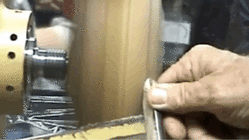
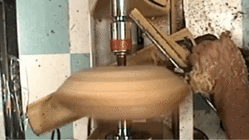
Turning a ball I need to see the shadow. Much easier to do switching hands
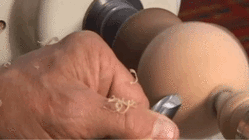
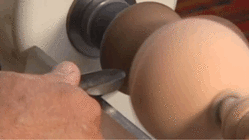
Agree with everyone else, ambidextrous turning is the standard. The sooner a beginners does it the better. There is a downside to instructors/mentors - they can have their own opinions on things, which aren’t necessarily correct.
Dave Landers
Beta Tester
I've said this before, but... here's one way of looking at it...
The bevel on the gouge controls the direction the gouge will cut. That, in turn, controls what position the tool handle is in. As a turner, your choice is: which side of the handle do you want to stand on? You can stand where all the chips and bark and stuff are flying at you, or move to the other side of the handle. You can stand comfortably or attempt to co-exist in time and space with the headstock or tailstock. You can switch the tool to cut in another direction, or reposition your whole body all the time.
Sticking to one hand means you are either compromising your safety or comfort, or you are compromising the best presentation of the gouge.
The cuts we make (ok, not all - but most) do not require significant hand coordination - one hand is holding the tool on the tool rest, the other holding the handle against our body.
Being comfortable with that is a big advantage. Doing it naturally is even better - most of us (well, me anyway) have had to retrain ourselves.
The bevel on the gouge controls the direction the gouge will cut. That, in turn, controls what position the tool handle is in. As a turner, your choice is: which side of the handle do you want to stand on? You can stand where all the chips and bark and stuff are flying at you, or move to the other side of the handle. You can stand comfortably or attempt to co-exist in time and space with the headstock or tailstock. You can switch the tool to cut in another direction, or reposition your whole body all the time.
Sticking to one hand means you are either compromising your safety or comfort, or you are compromising the best presentation of the gouge.
The cuts we make (ok, not all - but most) do not require significant hand coordination - one hand is holding the tool on the tool rest, the other holding the handle against our body.
Being comfortable with that is a big advantage. Doing it naturally is even better - most of us (well, me anyway) have had to retrain ourselves.
- Joined
- Feb 3, 2010
- Messages
- 11
- Likes
- 1
Hi, I'm new to turning and when it's more convenient I've typically switched my hands (left hand on my hip rather than right hand) rather than put my body in an awkward position.
When I was first learning I was the same way. In fact, I made a very similar post to a woodturning forum, and got very similar responses. Eventually, as I learned the finer points of tool control, I picked a side and stuck with it. I suspect you will too. Do what comes naturally and you'll figure it out. If you end up an ambidextrous turner, even better!
I think the easier solution is to have room on both sides of the lathe and put it in reverse, though I wouldn't be surprised if some manufacturer tries to make the whole ways rotate as a feature.This makes me think, if lathe mfr's. can build sliding and rotating headstocks, and outboard turning headstocks, it should be a natural extenstion to design a headstock that can be moved to the right end of the machine, and flip the tailstock accordingly, to the benefit of left-handed turners.
Please allow me to offer an analogy. In the world of basketball players being recruited by college programs the point guards that can dribble with either hand interchangably without hesitation garner the most interest and the most offers.
IMHO, continue to not only use both hands but further the development of both..
IMHO, continue to not only use both hands but further the development of both..
Ambidextrous turning is definitely a plus. Some cuts in specific cases are much easier with the 'other hand'. Working on my comfort level with left handed work has also helped when I'm teaching and have left handed students. In one case I was working with a left handed student, usually showing him what to do left handed but occasionally right handed. By the end of the class he had picked up some of the basics of right handed turning, and apparently didn't realize he was doing it. As many have said above, work on both!
Last edited:
The thing about turning with either hand on the hip or on the tool shaft is that you still move with your body, and not your arms. This is true about 90% of the time. Not too difficult of a skill to learn. Well, easier said than done....
robo hippy
robo hippy
do what works. The abiity to switch hands is a plus and let's me work next to the headstock
Thanks for all of the input. As most of you know, when you're new to something you question if you are doing it right, and/or second guess many of your decisions. Until I started turning bowls, I'd never thought about how many options and choices there are and am still working on figuring out why some may be better than others - but that's a completely different discussion. Thanks again!
odie
TOTW Team
- Joined
- Dec 22, 2006
- Messages
- 7,116
- Likes
- 9,828
As with others here, developing left-handed skills is a good thing.
For me, I avoid it, until it becomes necessary. When I use a gouge to its best advantage for getting the best cut in a complicated sweeping maneuver, it is rotated on its longitudinal axis, as well as lifting and lowering the angle it's presented to the wood during a single smoothly executed motion. For me, this is a skill that has never been as good left-handed as it is for doing it right-handed.....but sometimes it is necessary.
-o-
For me, I avoid it, until it becomes necessary. When I use a gouge to its best advantage for getting the best cut in a complicated sweeping maneuver, it is rotated on its longitudinal axis, as well as lifting and lowering the angle it's presented to the wood during a single smoothly executed motion. For me, this is a skill that has never been as good left-handed as it is for doing it right-handed.....but sometimes it is necessary.
-o-
Just remember this for all aspects of turning. This has been a focus of mine with turning - “just do what works” doesn’t work for me. Many things “work”, but many times a seemingly minor detail makes a certain method a better way. Its gaining the understanding how and why methods, tools, etc work to develop a best thing, at least to the person and their situation.I'd never thought about how many options and choices there are and am still working on figuring out why some may be better than others
- Joined
- Aug 6, 2006
- Messages
- 19
- Likes
- 292
- Location
- Waitahanui, Taupo, New Zealand
- Website
- www.wildwoodgallery.co.nz
It's a good idea to switch hands because there are cases where you need to turn left-handed. Keep it up Paul.Hi, I'm new to turning and when it's more convenient I've typically switched my hands (left hand on my hip rather than right hand) rather than put my body in an awkward position. I was taking a beginner class at our local club and the instructor was very surprised by this and made me feel like this wasn't a good idea. Most of the video's I've seen also don't show people switching hands, most people turn with their right hand on their hip and left hand near the tool rest. I'd be interested in what people here have to say on the subject, please let me know if I should stop switching - thanks!
The controls would then be on the wrong side of the headstock. You can do the same thing by going around to the opposite side of the lathe.This makes me think, if lathe mfr's. can build sliding and rotating headstocks, and outboard turning headstocks, it should be a natural extenstion to design a headstock that can be moved to the right end of the machine, and flip the tailstock accordingly, to the benefit of left-handed turners.
Oh look, I just created a marketing niche for some lathe builders...
Unfortunately, lathes are decidedly right hander tools. It's not fair, but it is what it is. As everyone on here has said though, being able to turn either handed is a valuable skill.
Last edited:
What you want is a sliding head with outboard set up on the left side. Would need a locking set screw and a taper so you can use your tools on the left side. Also you would have to move the tailstock and tool rest to the other side. A hassle. However the controls would be on the operator side of the headstock.This makes me think, if lathe mfr's. can build sliding and rotating headstocks, and outboard turning headstocks, it should be a natural extenstion to design a headstock that can be moved to the right end of the machine, and flip the tailstock accordingly, to the benefit of left-handed turners.
When I started turning my mentor said I should learn to turn with both hands as it will be a useful skill to have. Have used either hand as needed from day one. Found it to be very advantageous at certain times.
I’m naturally left handed. Spent my life learning how to do most physical things by watching mostly right hande4s do things, learning the skill then turning it all on its head and adapting what I’d learned to the left side. Turning has been the same - learn the skill (tool presentation mostly) then adapt it to the other hand. My mentor went with the flow - teaching me the way he knew how, then cringing slightly when I turned it all around. Eventually he discovered that I was then able to do pretty much everything from either side - a good thing.
When I was in second grade (parochial school) the nuns decided that they were going to force me to write with my right hand…my father, a dedicated baseball fan and little league coach had a little chat with them. He was determined to build the finest first baseman from the material he was given in spite of their problem with me using the ‘sinister’ hand to write with.
When I was in second grade (parochial school) the nuns decided that they were going to force me to write with my right hand…my father, a dedicated baseball fan and little league coach had a little chat with them. He was determined to build the finest first baseman from the material he was given in spite of their problem with me using the ‘sinister’ hand to write with.
When I was in second grade (parochial school) the nuns decided that they were going to force me to write with my right hand…
As with all classes and internet videos, you glean the things you like and work for you. No one MUST follow the advice. Every human has a primary hand, eye, etc....
Maybe it is like freestyle/crawl swimming where they say you have to be able to breathe on both sides. If you watch the Olympians, very few of them breathe on both sides, and always favor one. I swim one length breathing on one side, and the next length breathing on the other. Haven't ever needed it, but can do it just in case.... This makes me think of Ashley Harwood who can only sharpen on the left side of the grinder......
robo hippy
robo hippy
I wonder if any leftys stand on the other side of the lathe and spin the wood clockwise?ambidextrous turning would be a huge advantage in my opinion. I’m a lefty and trying to learn right handed also.
I finish bottoms and feet on many bowls with the lathe turning in reverse - but standing on the usual side of the lathe. Turning a gentle domed shape is much easier and more comfortable when you don’t need to reach way across the ways. I also learned to hollow with a D-Way hollowing tool in reverse…much better access and ability to see what you’re doing. Use the chuck’s grub screws, just in case, but haven’t had anything unscrew itself yet.I wonder if any leftys stand on the other side of the lathe and spin the wood clockwise?
If they do, they have to have a way to lock the chuck to the shaft.I wonder if any leftys stand on the other side of the lathe and spin the wood clockwise?
- Joined
- Apr 27, 2004
- Messages
- 8,641
- Likes
- 4,979
- Location
- Lakeland, Florida
- Website
- www.hockenberywoodturning.com
I’m left handed ( the only thing I do right handed is shoot an bow) and had to force myself to turn the inside of a bowl right handed, basically because I had no choice  . The outside of the bowl I turn mostly left handed, holding the handle in my left hand. I can turn the outside right handed but it is usually on the final two cuts of a finished bowl. I can do pull cuts and shear scrapes either handed.
. The outside of the bowl I turn mostly left handed, holding the handle in my left hand. I can turn the outside right handed but it is usually on the final two cuts of a finished bowl. I can do pull cuts and shear scrapes either handed.
The outside of a green bowl is completely turned left handed, kind of like Mike Mahoney does but I do glide on the bevel for most of the cut. I had no idea Mahoney was left handed until I was watching a video with Stuart Batty and he mentioned it.
Spindle turning is left or right handed as needed.
So being able to turn right and left has its advantages.
The outside of a green bowl is completely turned left handed, kind of like Mike Mahoney does but I do glide on the bevel for most of the cut. I had no idea Mahoney was left handed until I was watching a video with Stuart Batty and he mentioned it.
Spindle turning is left or right handed as needed.
So being able to turn right and left has its advantages.
Been a lefty for 71 years and have learned to adapt in a lot of things. Same with turning. I found I didn't have a problem switching hands back and forth and it seemed sensible to do it, so that's what I do. In a lot of cases it seems safer to do so too. By all means keep it up!I wonder if any leftys stand on the other side of the lathe and spin the wood clockwise?
Never really felt the need to change to the other side of the lathe, though I do prefer to move the headstock down for hollowing and work off the end of the lathe. I'd probably do that if I was right handed too though.
Off topic side story:
Weirdest situation I've encountered as a lefty was when my family moved to Switzerland for a couple years when I was nine (1961). I went to a public school and at that time they had an hour of penmanship every day, using steel tip pens and inkwells. Because of that, everyone learned to write right handed. First they tried making me use my right hand, but quickly gave up on that. Then I was allowed to use my left hand, but was still expected to use pen & ink and form my letters exactly the way the rightys did. Talk about a mess! I just smeared everything across the page. The final solution was the teacher getting special permission from school officials to let me be the only kid in the school system to use a ball point pen. I still had to make the letters look like I was using my right hand though! Aside from that, it was a wonderful experience living there. The Swiss people are polite and formally cordial to strangers, but once they realized that we just wanted to fit in, we became like family and got to see how great the community was. The other American families we knew went to private schools and kept to themselves and really missed out on a lot of great experiences.
Off topic side story:
Weirdest situation I've encountered as a lefty was when my family moved to Switzerland for a couple years when I was nine (1961). I went to a public school and at that time they had an hour of penmanship every day, using steel tip pens and inkwells. Because of that, everyone learned to write right handed. First they tried making me use my right hand, but quickly gave up on that. Then I was allowed to use my left hand, but was still expected to use pen & ink and form my letters exactly the way the rightys did. Talk about a mess! I just smeared everything across the page. The final solution was the teacher getting special permission from school officials to let me be the only kid in the school system to use a ball point pen. I still had to make the letters look like I was using my right hand though! Aside from that, it was a wonderful experience living there. The Swiss people are polite and formally cordial to strangers, but once they realized that we just wanted to fit in, we became like family and got to see how great the community was. The other American families we knew went to private schools and kept to themselves and really missed out on a lot of great experiences.
My father grew up in Switzerland and was whipped with a ruler across the back of his hand when he tried to use his left hand. He became a barely legible right handed writer. My 3 brothers and I are/were all left handed.
For turning, most cuts can me made right handed, but it's nice to be able to switch to keep out of the "line of fire" with more difficult cuts or pieces of wood. I don't really have a preference. People would sometimes ask me what hand I throw with, and I'd have to look at my baseball glove to answer.
We had to use fountain pens in grammar school, too (the parochial school that tried to change my ‘handedness’). Hard for a lefty, but I found that turning the paper 90 degrees to the left allowed me to write without smearing the wet ink…still do it to this day, and still prefer a fountain pen.. I went to a public school and at that time they had an hour of penmanship every day, using steel tip pens and inkwells. Because of that, everyone learned to write right handed. First they tried making me use my right hand, but quickly gave up on that.
Hah! I became a barely legible right handed writer and no one ever had to hit me to get me there.My father grew up in Switzerland and was whipped with a ruler across the back of his hand when he tried to use his left hand. He became a barely legible right handed writer.
- Joined
- Feb 28, 2021
- Messages
- 1,226
- Likes
- 1,075
- Location
- Roulette, PA
- Website
- www.reallyruralwoodworks.com
Or, like one lefty I met, learn to write backwards (from right to left!) I imagine it takes a lot of thought of how much space your words are going to take up from the right side of the page, though... I couldn't believe anyone capable of doing that unless I'd seen him in person....We had to use fountain pens in grammar school, too (the parochial school that tried to change my ‘handedness’). Hard for a lefty, but I found that turning the paper 90 degrees to the left allowed me to write without smearing the wet ink…still do it to this day, and still prefer a fountain pen.
Both are useful, so get at both. Instructors in all the classes I've taken, including professional turners and non-professionals, have always indicated that being ambidextrous is essential.

